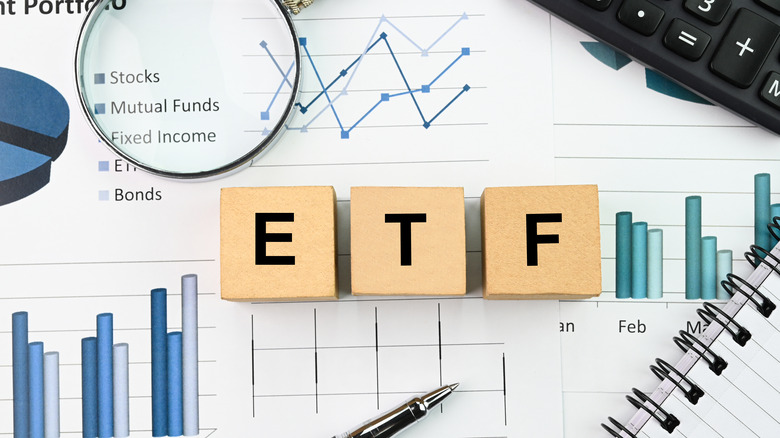10 Investment Opportunities That Make Financial Sense For Retirees
Retirees find themselves in a particular financial position that's totally unique in the consumer marketplace. Retired people are no longer working, and therefore need to derive their monthly financial support from alternative sources. Retirement income is a project that modern workers spend their entire lives building, and everyone's "magic number," so to speak, will be different. Generally speaking, however, your Social Security checks will replace roughly 40% of your pre-retirement income, on average, meaning you'll need to plan for a way to deliver another 30% to 40% in sustainable, monthly income sources. The best way to achieve that is through investments. Workers have access to a range of retirement savings products today, and investments in a Roth IRA or 401(k) bring tax advantages into the mix beyond the baseline of growth that's necessary to meet your targets.
But within (or beyond) these privileged retirement savings vehicles, it can be tricky to decide what to invest in. Retirees, in particular, have specific goals in mind and individual needs that don't align with the investment strategies of younger workers still trying to set aside enough cash to fund their later years. Instead, older Americans rely on strategies to continue growing their nest egg at a steady — if slower — rate while focusing primarily on defending the principal value of their investments. Running out of money is the main enemy here, and so a different tack must be adopted to continue funding a retirement lifestyle that's fulfilling yet financially sound. These investments frequently make the most financial sense for retirees trying to balance both objectives.
Tax-advantaged municipal bonds
Municipal bonds are some of the most interesting in this segment of the investment marketplace. Bonds, as a wide category of investment tools, are some of the best options in the market for retirees seeking to protect their portfolio value while still locking in growth. Generally speaking, bonds offer a guaranteed rate of return, and even though it's far south of the mark that you can expect to make in the stock market or elsewhere, that guarantee is crucially important. In many instances, there's virtually no downside (other than the opportunity cost of not investing elsewhere) to investing in a bond position.
Municipal bonds are one choice among the wider marketplace here, and they provide a unique tax advantage that makes them even more valuable than some other options. In many cases, a municipal bond holder won't have to pay taxes on the interest they receive from the investment. This makes them somewhat akin to the returns you can expect to see through your Roth IRA (as long as your distributions follow the 5-year rule, among a few other regulations). Locking in guaranteed income that isn't subjected to capital gains taxes and other forms of taxation that take away from your bottom line can be a huge benefit, especially if you're looking to deliver retirement income that's steady and still prioritizes principal defense.
REITs
Real Estate Investment Trusts (REITs) are another solid option for retirees hoping to deliver a steady stream of income replacing investment earnings. REITs are a particular type of fund that can be found in the stock market. They operate in much the same way as an index fund in that your investment in a single REIT stock is actually a purchase of many assets blended together under one umbrella. This gives you increased protection against volatility and downward market pressure. Unlike an index fund, a REIT is an investment bucket that bring this together tangible real estate properties rather than shares of companies. Prologis is the largest of the group, existing in the logistics real estate space and exhibiting a market capitalization of $102.56 billion – placing it in the same conversation as some of the largest companies in the market.
REITs feature a strict set of rules that make them unique in the market and interesting to investors. They must invest at least 75% of their total assets in real estate, cash, and treasury holdings while earning at least 75% of their gross income from real estate sources (like rent, mortgage interest, etc.). The most important feature for shareholders is the 90% of taxable income that is required to be paid out in the form of dividends. Generally speaking, REITs pay out far larger dividends than typical company shares as a result. This makes them a solid play for investors seeking to amplify the cash output they receive from their investments without having to sell out of a position.
Annuities
Annuities are an investment vehicle used to provide retirement income with easy to understand terms and guaranteed payout rates. They come in a variety of formats, so you'll have to do your research and determine the appropriate solution for your needs if you want to pursue an annuity contract. In some instances, you might divert a portion of your retirement portfolio in a single, lump sum payment to buy into an annuity product that immediately begins paying out distributions. Other annuities are funded through an investment window that you'll contribute to while still working and then take advantage of income payments once you leave the workforce — in a similar manner to your Social Security checks.
Some retirees will also want to bake inflation protection into their portfolio, specifically. Inflation-Protected Annuities (IPAs) are a great way to tackle this issue. These annuities provide a base payout figure that is then adjusted with an additional inflation factor to ensure that your actual benefit from the product isn't negatively impacted by rising inflation over the long term. No matter the type of annuity you select, it's important to note that these products are designed primarily to protect you by limiting your risk of outliving your savings. You might consider investing in an annuity that guarantees a payment that meets your entire budgetary requirements in order to completely eliminate any worry in this regard. Alternatively, you could select a smaller asset value that will cost less but requires you to still consider how to protect other elements of your portfolio.
ETF and index funds targeting the whole market or specific sectors
ETF and index fund holdings can't be spoken of highly enough. These asset classes bundle hundreds or even thousands of individual companies together into a single investment, taking the guesswork and extreme research requirements out of the equation as you attempt to make smart investment decisions. Naturally, you'll still need to evaluate an index fund or ETF's fundamentals and portfolio balance, but the risk and uncertainty surrounding your investment is significantly reduced with these assets.
Rather than picking individual stocks that you think will perform well and hoping for the best, these bundled assets deliver upside at a macro level. By investing in an index fund, you are essentially investing in a wide cross section of the market as a whole. These assets can be used to invest in broad terms like the S&P 500 in its entirety or in more targeted areas like the banking sector or small cap companies. No matter which approach you take within this segment of the marketplace, you'll enjoy a collapsed risk factor while still retaining significant upside potential over the long term. This is critically important for retirees who need to maintain at least a moderate growth factor in their portfolio but simply can't take on the same level of risk that a younger trader may welcome in their investments.
Brick and mortar real estate
Real estate is always a potentially lucrative investment opportunity. Time and time again, analyzing general wealth and investment return potential, the fastest growing opportunities frequently lie in the real estate space. However, this arena isn't without risk and therefore the marketplace isn't for everyone. Investing in a real estate property that pays monthly rental income is a great option for those who are willing to take on those additional risks. One way to mitigate this issue is by working with a property manager that you trust. Property managers take a percentage off the top, eating into your profits, but they remove you from the conversation and manage all the routine necessities associated with a rental property for you.
That being said, unlike investments in the stock market or elsewhere, investing in real estate that delivers routine income like this is partially an investment in people, making it potentially messy. A tenant who lives in your property can become a wild card depending on uncontrollable events in their own life. They might stop paying rent or damage the property severely because of a dispute or simple negligence. Therefore, investments in real estate aren't nearly as simple as transactional holdings in the stock market or elsewhere. If you buy an investment property with the help of a mortgage loan, good stewardship is essential to avoid the potential for foreclosure in the event that you're tenant stops paying rent and you have trouble servicing the loan. Even with all that being said, investments in real estate can be extremely lucrative for those who have the stomach for this unique risk profile.
Corporate bonds
Corporate bonds are another asset in the bond universe that can be useful if you are looking to hedge against downward market pressure or inflation. Unlike federal bonds and other governmental instruments, these are issued by companies in the corporate sphere. Corporate bonds are frequently introduced by gigantic companies that have long track records of positive performance. Companies like Apple and Amazon issue corporate bonds and they are frequently characterized by moderately high yields in comparison to other bond opportunities in the market.
Because corporate bonds are separate from the policies and fortunes of a federal or local government, yields offered in this part of the market can sway at different rates and in unique ways. Anyone scouring the bond market for good investment opportunities should always look to explore corporate bond alternatives to the standard treasury bonds offered by the federal government. Giant conglomerate brands are virtually just as stable in many cases as a government entity, and therefore can provide essentially the same level of guarantee when it comes to their returns. This means that if you can find a better rate from a corporate bond than the treasury bond you should probably take that opportunity instead of sticking with in more traditional investments.
High-yield dividend stocks
REITs aren't the only name in the world of high-yield dividends. A wide range of individual companies offer solid dividend payouts on a consistent basis, and can sometimes offer increased stability in the market when other assets are experiencing significant turbulence. Naturally, this is yet another area of the investment world where a one size fits all approach just won't cut the mustard. Everyone's risk tolerance will be unique and so will their knowledge across market sectors. One investor may be particularly bullish and comfortable with investments in the industrial sector while another finds the best value in tech stocks, as an example.
However, no matter where you place the majority of your focus, there's almost certainly going to be one or more dividend paying companies with high yields and decent upside for your needs. Another opportunity here is to focus on dividend aristocrats. These are companies that have increased the payout figure of their dividends every year for the last 25 years. While that trend isn't a guarantee, companies that have reached this enormous milestone typically won't change course unless they absolutely need to. This means you can generally expect dividends to continue rising over the long term with any company highlighted on a list of dividend aristocrats.
Treasury Inflation-Protected Securities (TIPS)
Treasury Inflation-Protected Securities (also known by the acronym TIPS) are a type of bond offered by the federal government. These assets feature a similar inflation protection factor that can be found in IPAs. As is the case there, the primary goal of TIPS is to deliver inflation adjusted value to investors. A combination payout figure is calculated, featuring a base interest rate that's augmented by a floating inflation adjustment. Upon reaching maturity, these securities payout to their owners at the higher figure of the original or adjusted principle, delivering both security against intense periods of inflation as well as their opposite in which inflation falls through the floor and an adjustment might actually create a negative impact for your security's augmented growth.
Federal bonds are traditionally a great way to protect your principal investment. Older Americans frequently employ a diversification strategy in which they shift an increasing volume of capital into bond holdings the closer they get to retirement (and beyond that transition). That delivers increased security for the principal value while still adhering, albeit with a lighter touch, to the desire to continue seeking growth. TIPS are a solid option for those worried about inflation while also looking for a more stable investment option that will help introduce financial stability throughout retirement.
Consider gold and other precious metals, too
Precious metals like gold bullion and silver coins can be immensely valuable to investors of all walks of life. Retirees who want to spread their investment portfolio into a few different buckets might be attracted to the longevity of bullion and coin holdings, in particular. These involve differing timelines for use, and the longest-term investments are generally best served by growth stocks and other slow moving assets that protect their value well. Gold and silver tend to feature relatively stable valuations, with intermittent periods of tremendous growth (and occasionally decline) when demand spikes or abates. With that said, investments in precious metals tend to provide solid defense against rising inflation and other negative market pressures. This makes them a good option for times when your research suggests a lasting difficulty within the wider financial markets.
On the other hand, holding tangible gold and silver assets can be a challenge. For one thing, you'll have to physically protect these investments. Losing a sleeve of gold coins or even being burglarized will shed you of this investment without a whole lot of recourse to help you get it back. Liquidity can also be a problem when holding gold bars and other physical precious metals assets. However, the modern marketplace has found a way around both of these sticking points. Buying into a gold ETF gives you access to precious metals commodities without the liquidity problem, and using a vault service – something typically offered by modern online metals retailers – eliminates the security concern. Either approach solves one of the two primary hurdles that limit access, making precious metals a realistic option for stable wealth protection.
And don't forget about your emergency fund
Finally, it's absolutely imperative for retirees to keep their emergency fund in mind. In retirement, the necessity of an emergency fund can seem like a bit of a redundancy. After all, the principal value of your portfolio acts as something of a backstop, doesn't it? But the truth is that an emergency fund in retirement acts as an all-important buffer to protect your investments in the event of a sudden need for increased spending. While aimed at insulating you against a different spending alternative than in your younger years – where an emergency fund can protect you against relying on debt products to cover a surprise expense – the objective and result is the same. Instead of borrowing from a credit card company or other lender, without an emergency fund you will have to borrow against your future by drawing down on your portfolio faster than anticipated. Additional withdrawals can also increase your tax burden, depending on where the money is sourced from.
AARP suggests that retirees should consider expanding their emergency fund rather than minimizing it, as well. While a typical worker should ultimately aim to set aside three to six months' worth of funding for emergencies, retirees should seek to add to this line of protection with coverage for six to nine months' worth of bills and routine expenditures. Older Americans increasingly find themselves squeezed by factors that they can't control, like inflation and required medical care. Adding to the cash reserves you have on hand will protect your retirement income sources and keep you living a happy and rewarding retirement lifestyle for many years to come.










